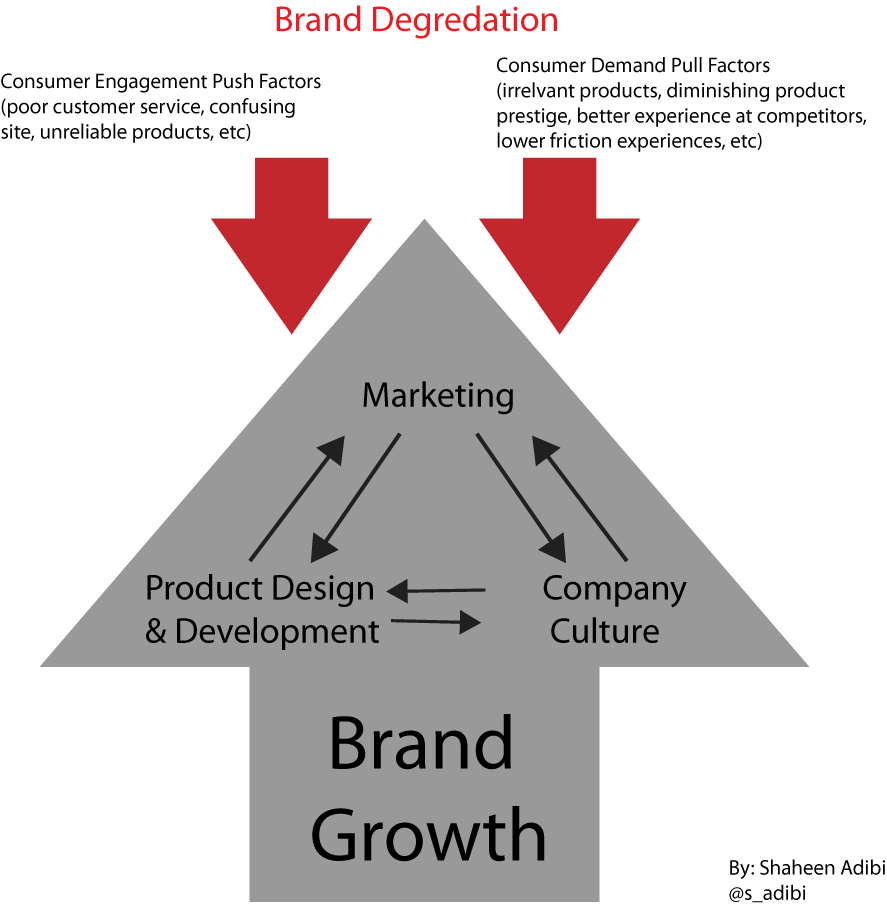There are no longer any silver bullets in digital marketing. We don’t operate in a world of marketing asymmetry, or an Internet devoid of slow moving traditional companies. 15-20 years ago it was fine to rely on just Email, just SEO, or just Display Ads. But now it isn’t a matter of finding some new tactic, but using the full spectrum of digital technologies to connect with audiences in the traditional sense while exploiting tech’s profit margins.
Great marketing is derived from a perspective that asks whether our brand matters to our customers, and then reinforces the achievement of that customer value throughout their buying journey. Marketers then need to ask ourselves how our marketing efforts can reinforce our connection and service to our community as our brand grows. Great marketing demands a feedback loop between a company’s culture, product development, and marketing efforts.
Viewing marketing this way prevents short-term thinking and eventually falling into mediocrity. It also helps brands become the experience leaders that reap profitable returns in the long run rather then throwing money into some form of marketing and hoping that it works.
As a company grows market share isn’t cemented to its tactics, but built on how those tactics allow it to connect and fulfill the company’s vision. From the customer’s perspective, a company that doesn’t have a core mission can’t articulate its strategic aims, never gets above the noise, and doesn’t matter.
Why Marketing Fails
Fighting to Matter
Today being visible to consumers, just so that you can even fight for the attention and the honor to matter in their minds is the limiting ingredient in successful marketing. No one needs to be told that competition is getting faster and faster. But the cognitive dissonance between reality and the myth that there is some tactic that could and should save an ailing business is ludicrous. The future belongs exclusively to the brands that can juggle multiple product lines and service offerings across myriad niche communities while facilitating experiences enhanced by your brand.
Marketing fails for a variety of reasons, but most derive from a combination of either:
1) a terrible product or service
2) poorly allocating channel or tactic investment
3) failing to question the strategic assumptions a business was built on
4) failing to react to a shrinking market or tactic that’s losing effectiveness
In the following piece I will explain how these four traps happen and can be avoided.
A terrible Company, Product, and/or Service Can’t Hide
As a child I remember going to the same terrible restaurants family members had been going to for years. Back then you could rely on location and word of mouth to hide behind chicken alfredo that was a smidgen above the canned equivalent. But now, even if information isn’t fully democratic “the rabble” can and will burn down your castle if your product doesn’t satisfy.
We’re all hopefully cognizant of the fact that the Internet has disrupted the possibility of information asymmetry between buyers and sellers while eviscerating the geographic benefit of location. But fewer have adapted their marketing strategies to the fact that social media and human optimized search have tilted digital marketing tactics away from an ROI calculation to whether you matter to your end customer. Information is cheap but the expertise to use that information or ability to create a magical experience is something that businesses can still offer their customers. The companies that pursue this level of engagement will ultimately build the trust that lead to sales that benefit both sides.
Understanding How Google Works & Why Marketing Doesn’t
Marketing channels have exceptionally small windows of functionality and using a tactic and receiving peak returns from it only occurs during a certain epoch of a cycle. This means that even at the risk of a platform going under ( MySpace ) or becoming a niche ( Vine ) there is still a first mover advantage in riding the wave before it breaks. (Or you could go for the Peter Thiel / Samsung Route and aggressively press second mover advantage.) The perception of weak marketing performance typically starts because most companies buy marketing tactics in a channel on the expectations of their peak wave, rather than their marginal plain. This of course isn’t to say that a variety of “dead” tactics can’t bring business results or that a tactic one company is doing couldn’t be done better. But for peak business growth it means that being risk averse to new channels, and the tactics within them, will leave your profitability trending on the average, rather than the optimum.
How Most Companies Buy Marketing:How Most Companies Buy Marketing:
Figure 1: How Most Companies Buy Into Digital Marketing Channels
This happens for a few reasons
The first is that channels die quickly, attention is rare, and information is so diffuse that communities dissolve even faster.
For every plausible channel where a marketing tactic exists the time between having first or even second mover advantage and returns normalizing at a marginal rate is shortening, (As a note – every industry and vertical develops on a channel develops it’s own ROI ceiling and price floor as it’s usage normalizes over time. Thus your spend in X channel may still have the possibilities of a higher return, but is unlikely to reach peak returns.) What I’ve labeled as “Marginal ROI” above). Giving us sharper oscillations, or channel windows, as more web 2.0 & 3.0 firms flood the market. It’s worth noting that these waves could still be years in the making. Look at MySpace in the figure below. In 2006 it would have been a great platform to invest time in, by 2008 that would have been foolish to do so. Obviously the picture is incomplete, but if we add in Digg, Google+, or even TV on a longer time frame the trend should be self-evident.
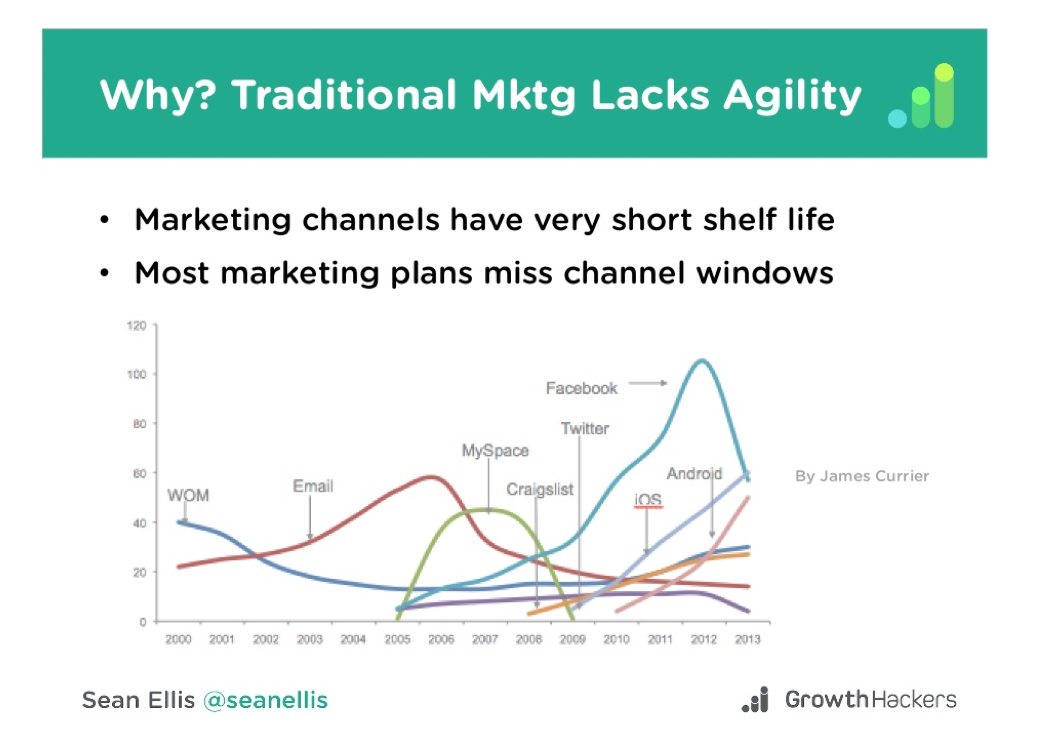
Of course a handful of extremely notable social platforms didn’t even make it on the above diagram because they’re functionally gone. The point is that it’s hard to attract a crowd at a cocktail party when the rooms already full. But if you’re there when it’s a known good party, you have all the advantage of gathering a crowd before it get’s too loud.
Second as Gary Vaynerchuck so succinctly puts it is that marketers ruin everything.
From Channels to Tactics.
Every business has a set of marketing channels that work best. And every marketing channel has a specific set of tactics that are worth executing for a given vertical. And in fact, if we take the arc of Google trend data and stack it up, we can see the gentle rise and fall of interest in tactics over time. Something that anyone in marketing intuitively feels, and likely maligns as the buzzword orientation of the industry.

Caveat: Since it indicates search data this is not a perfect comparison given that the word’s used in queries can change over time and the level of familiarity on a topic can inversely affect search volume. For clarity: PPC, SEO, & Content Marketing are tactics within search marketing channels and on the Google platform. CRO & Content production are tactics within owned channels on your own platforms. Each Social Media platform is its own channel.
Despite the imprecision of the above observation, interest precedes knowledge of a particular tactic and therefore the saturation point of a given tactic, which leads to either a response (Google update), loss of efficiency (increased cost-per-click on PPC), or complete obsolescence. (Like the utter filter for display ads I developed at the age of 11) Once demand builds for a “proven” tactic that will naturally force up it’s costs and normalize its maximum ROI. (again what you can see in Figure 1 where Marginal ROI is noted)
Smaller Marketing Trends
Note: I’ve used Outbrain out of curiosity since it dwarfs native ads as a search trend.
If we look at more minor tactics, we can see this same response, wherein we’re living through Facebook’s rapid rise in interest around advertising, and about to watch its steady decline towards marginal returns. (Though don’t sell your stock yet since Instagram is on the rise) Note that this is happening even as the company launches more and more digital ad products and especially because everyone’s in the game. The continuous challenge is that the world gets ever more crowded, loud, fast, and tribal.
Lets look at Google, one of the most disruptive forces in marketing and in the economy right now, where we can clearly see the diminishing returns of singular tactics over time. (And why we once thought that was enough.)
How Google Worked In The Beginning
This will be a bit of a conceptual thought experiment, but it should illustrate exactly why we can’t rely on singular tactics at the risk of not building up the emotional investment to matter to your customers. Imagine that the red dot is your intent when you use a product like Google, or any search engine (Amazon, Spotify, and the iTunes store count) to find a product. The black bars each represents Google’s technical ability to match your intent with a query it can use to comb its data and find you answer. Each spoke then represents a particular component of the ranking algorithm that might aid them in doing so. (And which I, the marketer, game.)
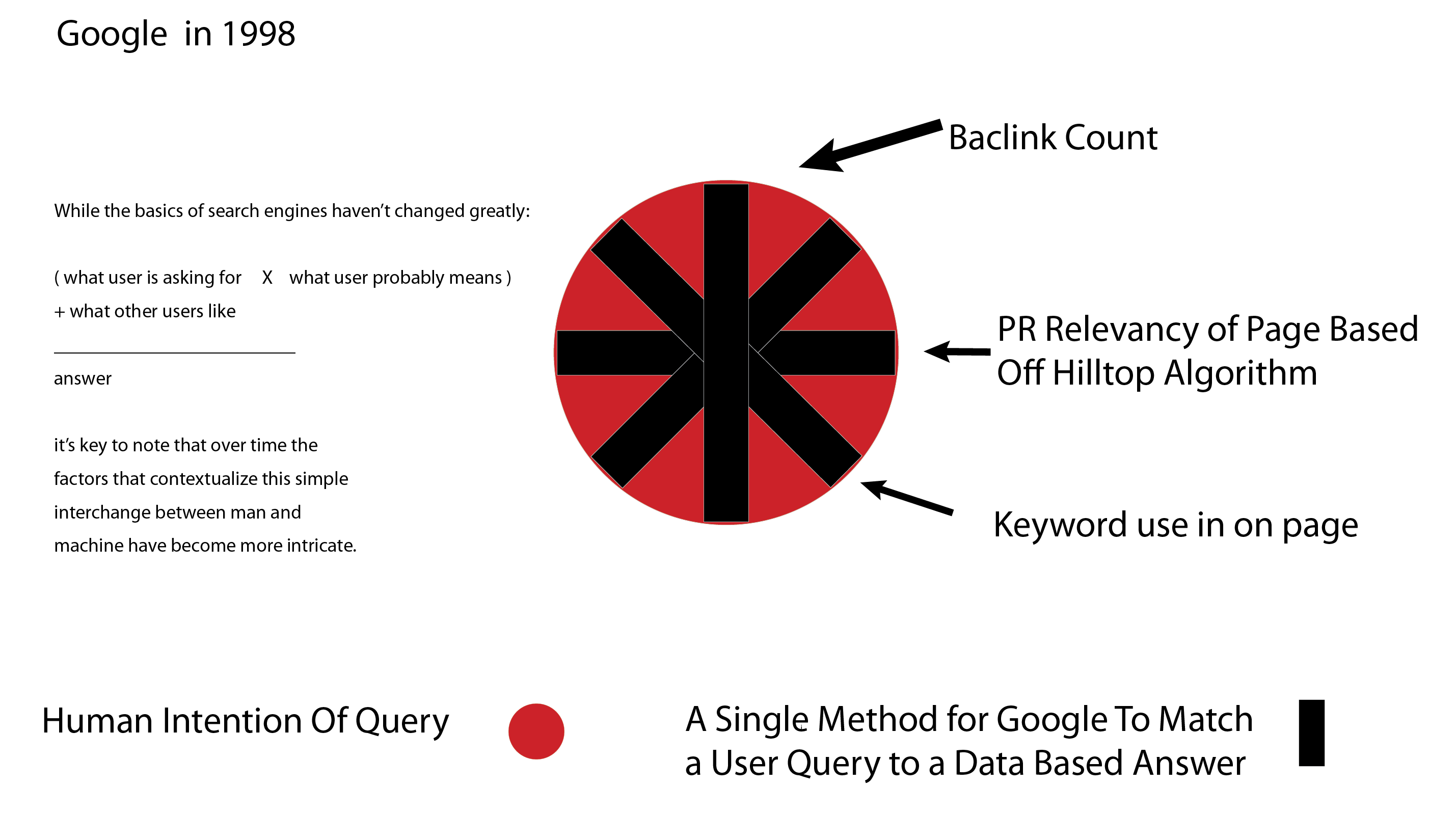
When Google first arrived on the scene, and gasp actually worked, it’s algorithm probably looked loosely like this:
1. A combination of on-page factors, if I’m searching paper planes is the site about paper planes? How many times does it mention paper planes?
2. A combination of authority signals from backlinks, like in science papers, whereby a site is heavily referenced and therefore likely important.
3. And just user query matching, the guy typed in paper planes, he must mean paperplanes.com right?
If we imagine each of the mechanisms Google’s algorithms used to match its database of facts to the complexity of human knowledge and desire, it becomes apparent that of course it was okay to concentrate on SEO, or link-building or having an exact match domain. Because even a few years ago those factors alone made up enough of how Google assigned meaning.

But of course marketers ruined that, so onto the next iteration:
How Google Worked in 2010
Now if one were to fast-forward to around 2010 Google, and now Bing, are around here conceptually. You can see that there are a huge variety of spokes in the wheel that makes up how Google seeks out information. Sure SEO and Link building still get you tons of bang for your buck, but they aren’t net dominant in the final answer Google chooses, and importantly humans don’t care. It’s good enough.
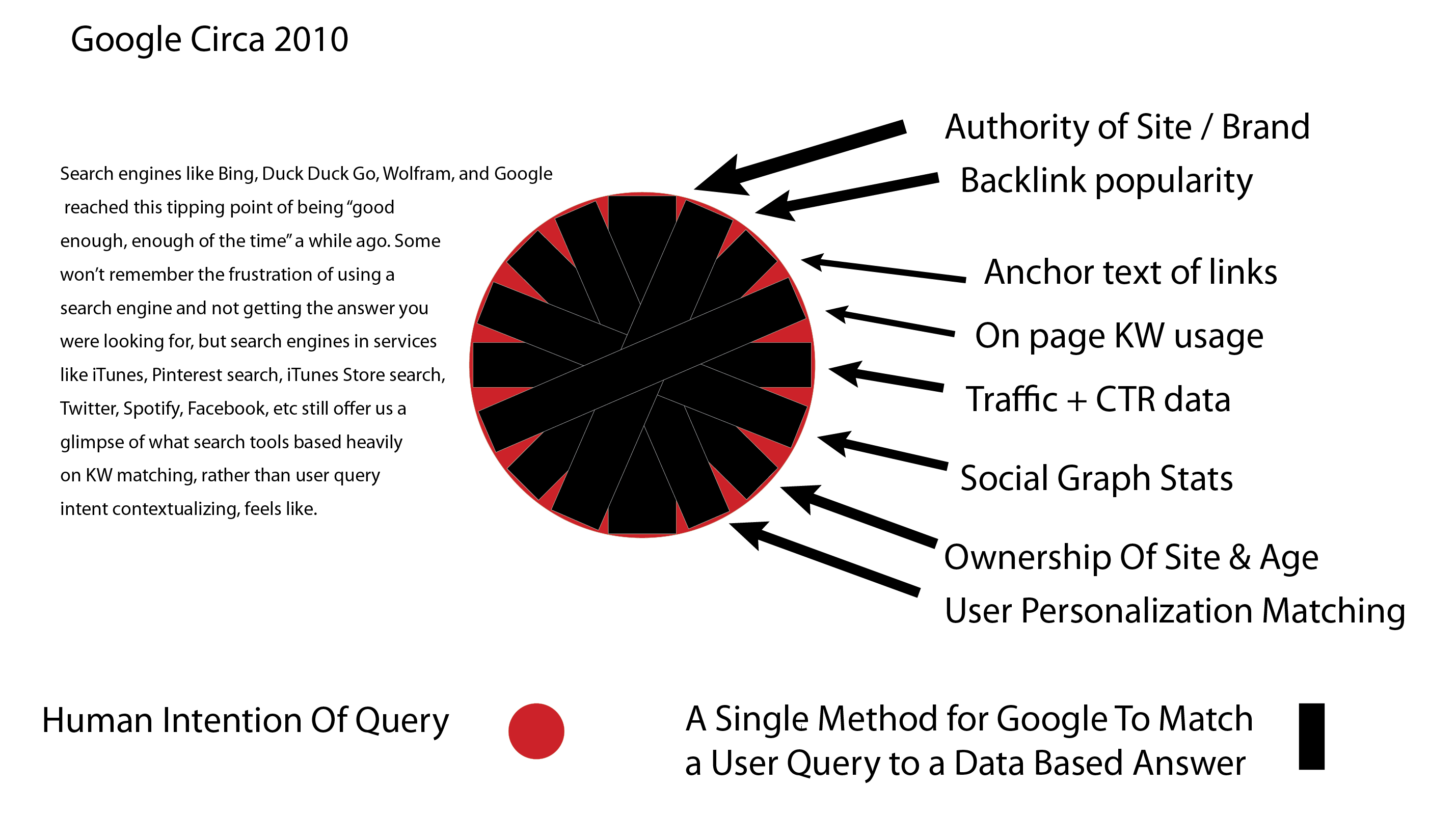
Welcome to the future, marketing is about people and not the machines. (Thus why Google is now hybrid with dual algorithms running one of which is an algorithm to build algorithms around what humans will like.) Inasmuch as we can still game and optimize for the indicators that Google uses to return results (aka why I still have a job) it’s important to acknowledge that Google is about serving people well. Just as all companies are about serving people well. Thus while I can still optimize some cogs in the black wheel above, which may optimize 12-20% of the final Google answer with equivalent results on revenue, it’s not the 35-70% of the scope that it may have been ten years ago.
Thus your digital marketing needs to cater to people, not machine based indicators because Google is chasing what people like. And if you want to get the best long-term results as a business owner you need to matter in the minds of consumers.
Nowadays if I type in “paper planes” depending on my search history Google may take me to the most topically relevant site on origami with the best tutorials on building paper planes, a local boutique, or to a music video. In default of having data on what I want, it will just take me to what the majority of other people liked.
Why You Need to Make your Mark and Matter Now:
Eventually Google will get to the point below where it’s mastered the search algorithm to such a degree that it can almost always almost perfectly match user queries to search intent. At which point past technical tuning will have little effect outside of having given you the opportunity to fight for your chance to matter in the future. At this point factors like on-page ranking, backlinks, and even bounce rate may be a minute part of human search on search engines. Google or some other engine may already know what the best answer is to a query even if it was just written or before it had the time to accrue ranking factors.
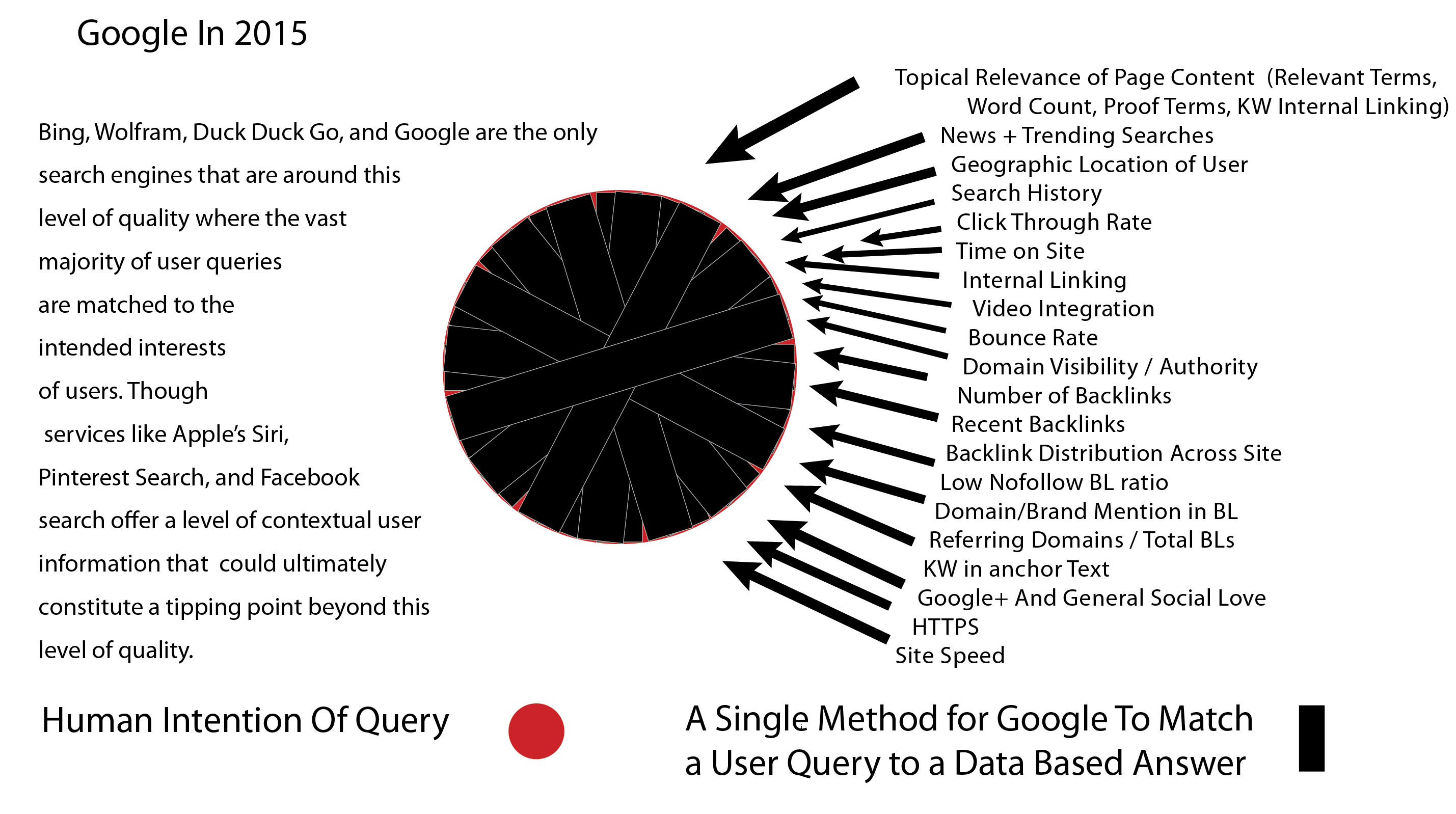
The future of Algorithms
Eventually algorithms will reach such a point that they fully supersede our cognitive awareness of our own needs, the computer based assistants will respond to our desires before we’re even reticent of them.
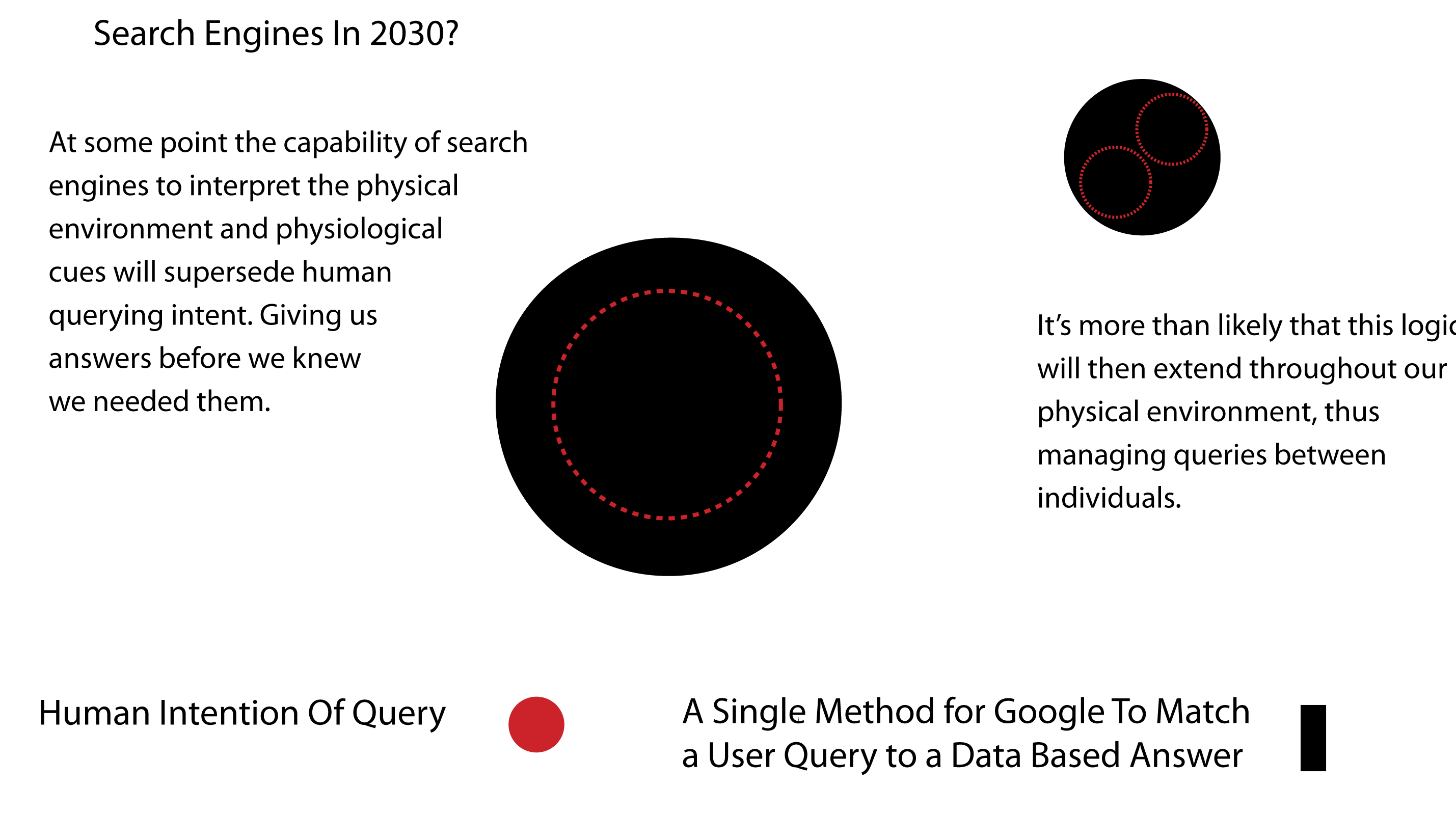
Every Marketing Opportunity presents a strategic inflection point.
Bringing it back to earth – as we’ve already seen, every marketing tactic as it presently stands has a corresponding peak and trough, and this oscillation across platforms and within the tactics that function there is occurring at a higher pitch. For digital agencies and marketing departments within companies this then means that in order to be successful you must remain adaptive and inquisitive.
The death of a silver bullet strategy where the optimal ROI from one tactic is enough to build an entire business endeavor, PPC 4 years ago, SEO 2 years ago, FB ads in a year, and maybe content marketing in a few years, means that we cannot have any illusions about a singular fix. The rise and fall of peak performance is best conceptualized by Andy Grove’s business application of The Inflection Curve. This rise and fall of every tactic presents a lost opportunity and moment to reflect on new possibilities.

taken by author from Only the Paranoid Survive, Andrew Grove.
Personally I love this because it means lazy competitors who’ve ossified on one tactic will perish. If the paranoid observe and react quickly enough to the rising signs they ride the upward stroke of new possibilities. We can see this in marketing tactics like adwords, which while always fraught with challenges can also diminish in value for businesses quite quickly once marginal returns are reached.
In the same manner that the Kodaks, the Blockbuster’s, the Tower Records, and the Blackberry’s of the world fell by not responding to incumbents and consumer demands, marketing can fail companies who don’t adapt their focus.
Use your silver bullets to shoot your one trick Ponies
So as an agency or an in-house marketing person, or someone who decides whether these two options are working, what should you do?
I like to harken back to Ian Lurie’s Law of Client Inevitability, and connect the dots back to digital strategies that have adapted well to strategic inflection points.
Ian Lurie’s Graph of Inevitability from ‘One Trick Ponies Get Shot’
Really the graph of inevitability reflects a reality within the digital marketing buying cycle as it currently stands, and even product lines in corporations, fail to adjust their marketing packages to the landscape of an industry. We naturally optimize tactics that work and when they stop working for a business, or stop working altogether, we fail to change course. Thus we’ve responded poorly to a strategic inflection point and our perceived worth has leveled off in the eyes of clients or you’re ready to fire your in house marketing guy. Worse still companies buying or doing their own marketing haven’t seriously considered whether, amongst all the competition and choices, they matter to their customers.
If you combine how clients buy marketing, with the reality of inflection points, and the client inevitability curve you get an accurate representation of the digital marketing landscape over time and where marketing ROI and company profitability end up.
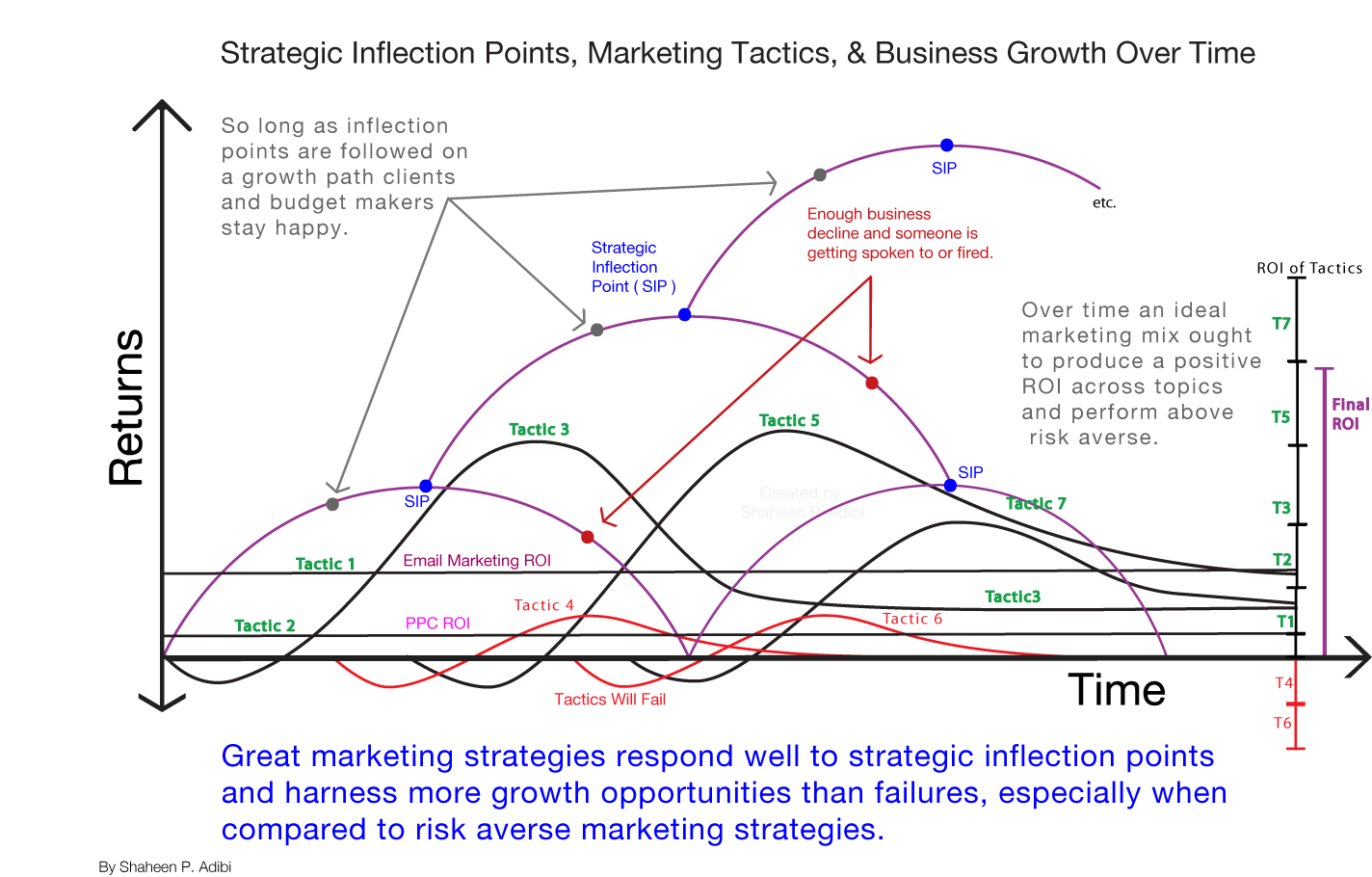
In the example above the company has introduced 5 new marketing tactics over time. At the start of the graph it’s marketing only constituted email marketing and PPC at their marginal ROI. By the end they’ve had a few failures, but they’ve also benefited from capturing peak ROI from the 4 strategies that did succeed. It’s important to note that, even though the ending marginal ROI for these tactics wasn’t as high as email marketing that doesn’t mean they weren’t worth doing, because 1) there no guarantee that that would have been the case 2) there’s no guarantee that any previously dependable tactic won’t decline eventually. Finally the success of any new tactic increases the value of the strategies being mixed as a whole.
Broadly hitting 0 or negative on the ROI curve above reflects the fact that a company has over-optimized on a particular tactic, built a digital agency on say link-building or bought into a corporate strategy that failed to adapt. The greatest dangers for companies isn’t losing money but not realizing how far down they’ve slid in standing with the rest of the market.
What bad companies sell doesn’t matter they just market the product.
Great companies matter, and you know it.
Minding that You Matter:
Well how do we respond? In the short term we must strive to escape the digital marketing valley of death. We must adopt an ideal marketing mix that stacks each of the marginal tactics best suited to our vertical, investigates upcoming inflection points and hustle until we prosper.
The reality is that the generation of much maligned millennial and those coming after them have a tight filter for ads, jump automatically to their phones, don’t rely as heavily on traditional media platforms, and can sniff out a fake company in moments. In a word companies who don’t walk the talk, charlatans, are summarily condemned.
‘Charlatan, Martyr, Hustler’ by Joey Roth
In a world where companies are guilty until proven innocent and consumers differentiate between brands more stringently than products, building a business that walks the talk and reflects that it matters to its customer base is the only option for growth.
The sooner we view marketing efforts as an opportunity to matter, to extend the core of our mission, rather than profitability, the longer we’ll be in existence. When resources are cheap, information is expensive. When resources are expensive raw materials are pricey, and no material in the digital economy is more expensive than attention. Right now access to information is cheap on the Internet. The challenge is that the raw materials of business success, resources like expertise to benefit customers and the gathering of attention, which enables brand experiences which ultimately lead to buying, is in short supply.
The new reality is that sales is about starting a relationship with your customers, and letting them buy into the relationship. Branding is about valuing your customers, their community, and the planet before they even think to value you. At that point you’ll have proven that you matter.
Don’t bookmark it, live it; some key takeaways :
Marketing Like You Matter:
1. No amount of marketing can save a bad product or business.
2. User attention and care is a rarer and more valuable resource than cash. (No attention or audience, then no sales or brand)
3. Channels and their plurality of tactics have, and reach, marginal returns at faster and faster rates.
4. Successful marketing constantly responds to strategic inflection points by devising a new optimal marketing mix of tactics based on where their targeting audience is placing their attention.
5. Every person in an organization is a salesperson – and satisfied customers, partners, members, whatever you choose to call them – are your highest converting salespeople.
6. A brand must matter in the mind of society, or perish.

